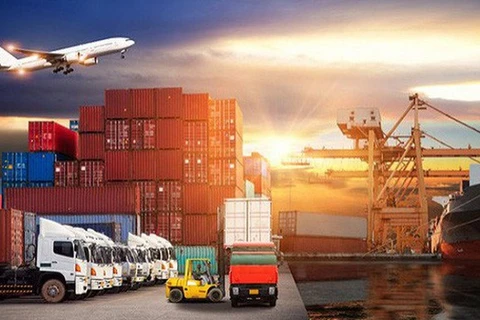Hanoi (VNA) – With borders closed and travel restricted since early 2020, cross-border e-commerce has proved itself as a game changer, setting the scene for Vietnamese traders to climb up the global supply chain and reducing risk of disruption caused by an unprecedented crisis like COVID-19.
Vietnam is among countries with the world’s fastest growing e-commerce, said Lai Viet Anh, deputy director of the Vietnam e-Commerce and Digital Economy Agency (IDEA). Last year, local e-commerce revenue grew 18 percent to reach 11.8 billion USD, accounting for 5.5 percent of total retail sales of consumer goods and services nationwide.
Given that global B2C e-commerce turnover is expected to hit over 2.88 trillion USD in 2023, cross-border e-commerce will be a very effective channel for enterprises to expand markets, she said.
The COVID-19 pandemic has been having adverse impacts on traditional in-person trade, said Tran Quoc Toan, Director of Co Do Co., Ltd., a producer of Vietnamese handicrafts which has exported its products to 50 countries and territories. His company has been displaying products on the world’s largest online marketplace Amazon in a hope of reaching more foreign customers.
Using Amazon, Co Do expects to sell its handicraft products directly to end users, Toan said.
Another handicraft manufacturer, Vinescraft Co., Ltd., used to access overseas markets via a network of importers, distribution centres, shops and sellers. The Hanoi-based company started selling products on Amazon five years ago, said Director Tran Duc Chung, adding that it took him two years to explore American taste and learn how to make use of the e-commerce website.
Vinescraft now receives around 300 – 500 orders, worth 19 – 40 USD each, every day, Chung said.
Any digital platform has its own pros and cons, so the most important thing is to find the compatibility between a producer and the cross-border online marketplace it uses in order to boost sales, he shared. Firms must also quickly adapt to changes in customers’ needs and the website’s policies to be able to succeed, he added.
According to data from Amazon Global Selling Vietnam, total sales of Vietnamese sellers on Amazon exceeded 1 million USD mark in 2020, tripling 2019’s figure.
Vietnamese enterprises should further accelerate digital transformation, look towards sustainable development and diversify distribution channels, Gijae Seong, Vietnam Country Manager for Amazon Global Selling, said. They also need to be adaptive to consumers’ changing needs and optimize products and services based on customers’ reviews.
The pandemic has created tremendous pressure for change and new ways of doing business for firms, even small ones, Anh said, emphasizing the need for support from major e-commerce platforms that operate on a global scale.
Director of the Hanoi Department of Industry and Trade Tran Phuong Lan said the capital city plans to organize an exclusive event on trading on Amazon for local handicraft products and craft villages in the coming time, as part of an effort to stimulate cross-border e-commerce.
The department will also hold a number of seminars and training courses for small- and medium-enterprises in the city regarding how to register and sell products on online marketplaces, she revealed./.
Vietnam is among countries with the world’s fastest growing e-commerce, said Lai Viet Anh, deputy director of the Vietnam e-Commerce and Digital Economy Agency (IDEA). Last year, local e-commerce revenue grew 18 percent to reach 11.8 billion USD, accounting for 5.5 percent of total retail sales of consumer goods and services nationwide.
Given that global B2C e-commerce turnover is expected to hit over 2.88 trillion USD in 2023, cross-border e-commerce will be a very effective channel for enterprises to expand markets, she said.
The COVID-19 pandemic has been having adverse impacts on traditional in-person trade, said Tran Quoc Toan, Director of Co Do Co., Ltd., a producer of Vietnamese handicrafts which has exported its products to 50 countries and territories. His company has been displaying products on the world’s largest online marketplace Amazon in a hope of reaching more foreign customers.
Using Amazon, Co Do expects to sell its handicraft products directly to end users, Toan said.
Another handicraft manufacturer, Vinescraft Co., Ltd., used to access overseas markets via a network of importers, distribution centres, shops and sellers. The Hanoi-based company started selling products on Amazon five years ago, said Director Tran Duc Chung, adding that it took him two years to explore American taste and learn how to make use of the e-commerce website.
Vinescraft now receives around 300 – 500 orders, worth 19 – 40 USD each, every day, Chung said.
Any digital platform has its own pros and cons, so the most important thing is to find the compatibility between a producer and the cross-border online marketplace it uses in order to boost sales, he shared. Firms must also quickly adapt to changes in customers’ needs and the website’s policies to be able to succeed, he added.
According to data from Amazon Global Selling Vietnam, total sales of Vietnamese sellers on Amazon exceeded 1 million USD mark in 2020, tripling 2019’s figure.
Vietnamese enterprises should further accelerate digital transformation, look towards sustainable development and diversify distribution channels, Gijae Seong, Vietnam Country Manager for Amazon Global Selling, said. They also need to be adaptive to consumers’ changing needs and optimize products and services based on customers’ reviews.
The pandemic has created tremendous pressure for change and new ways of doing business for firms, even small ones, Anh said, emphasizing the need for support from major e-commerce platforms that operate on a global scale.
Director of the Hanoi Department of Industry and Trade Tran Phuong Lan said the capital city plans to organize an exclusive event on trading on Amazon for local handicraft products and craft villages in the coming time, as part of an effort to stimulate cross-border e-commerce.
The department will also hold a number of seminars and training courses for small- and medium-enterprises in the city regarding how to register and sell products on online marketplaces, she revealed./.
VNA
























